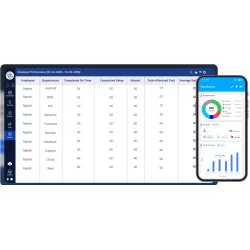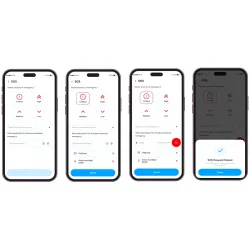
Why Proper Fleet Management Matters
Fleet vehicles are vital assets for industries such as logistics, construction, transportation, and delivery services. However, without a structured approach to managing and organizing these assets, businesses risk operational inefficiencies, rising costs, and avoidable downtime.
Disorganized fleets often face issues like missed deadlines, excessive fuel usage, maintenance delays, and compliance violations. In contrast, an efficiently managed fleet enhances service quality, improves safety, reduces costs, and drives long-term business success.
In this article, we explore the most effective strategies to manage and organize your fleet vehicles—equipping your business with practical tools and proven best practices.
1. Centralize Operations with Fleet Management Software
Digital transformation is key to modern fleet management. A centralized software platform allows you to monitor and control all aspects of your fleet in real time, using a single dashboard.
Key Benefits of Centralized Systems:
-
Real-time GPS tracking and vehicle monitoring
-
Automated maintenance alerts and service logs
-
Fuel usage and mileage tracking
-
Driver behavior insights (e.g., idling, harsh braking)
-
Instant alerts for registration, insurance, and inspection deadlines
With full visibility into your fleet’s activity, managers can make faster, more informed decisions that enhance productivity and accountability.
2. Create and Maintain a Preventive Maintenance Program
Preventive maintenance helps extend the lifespan of your vehicles and reduces unexpected breakdowns. Implementing a structured maintenance plan keeps your fleet reliable and roadworthy.
Maintenance Program Essentials:
-
Scheduled inspections for brakes, tires, and fluid levels
-
Regular oil changes and filter replacements
-
Battery, engine, and suspension checks
-
Tire rotations and alignments
-
Digital tracking of service history and upcoming tasks
Fleet software can automate service reminders and maintain records, reducing repair costs and improving compliance with safety regulations.
3. Optimize Routes for Fuel and Time Efficiency
Fuel is one of the largest operating costs in fleet management. Route optimization software analyzes multiple variables to help you reduce mileage, avoid traffic, and deliver on time.
What Route Optimization Should Include:
-
Real-time traffic and road condition data
-
Delivery time windows and scheduling
-
Vehicle type and capacity considerations
-
Past route performance analytics
With optimized routes, you’ll reduce idle time, lower fuel consumption, and boost on-time delivery rates—benefiting both your bottom line and customer satisfaction.
4. Train Drivers for Safety and Operational Excellence
Your drivers directly impact your fleet’s safety, efficiency, and public image. Regular training ensures they’re equipped to handle their vehicles responsibly and adhere to best practices.
Driver Training Program Topics:
-
Defensive driving techniques and accident prevention
-
Pre-trip vehicle inspection routines
-
Safe cargo loading and securing methods
-
Compliance with traffic laws and regulations
-
Usage of telematics and tracking tools
Training leads to fewer accidents, lower insurance claims, and improved fuel efficiency—while also strengthening your safety culture.
5. Use GPS Trackers for Real-Time Monitoring and Control
GPS tracking systems give you real-time visibility over your entire fleet. These devices allow you to monitor location, vehicle status, and driver behavior around the clock.
Benefits of Real-Time GPS Tracking:
-
Live location updates and route history playback
-
Geofencing to define approved operation zones
-
Alerts for unauthorized movement or prolonged idling
-
Theft prevention and fast recovery
-
Performance analytics through telematics integration
GPS trackers also empower dispatch teams to respond faster, improve efficiency, and reduce operational risks across the board.
Frequently Asked Questions (FAQs)
What is fleet management software and why do I need it?
It’s a digital platform that helps monitor, schedule, and optimize fleet operations. It improves visibility, reduces manual work, and ensures efficiency.
How often should I service my fleet vehicles?
It depends on usage, but generally every 5,000 to 10,000 km. Preventive maintenance should also include monthly checks.
Is GPS tracking worth it for small fleets?
Yes. GPS trackers are scalable and offer great ROI even for businesses with just a few vehicles.
Can I reduce insurance premiums by managing my fleet better?
Absolutely. Insurers often offer discounts for fleets with GPS tracking, driver monitoring, and safety training in place.
Related Articles
Final Thoughts
Managing your fleet effectively isn’t just about knowing where your vehicles are—it’s about maximizing efficiency, safety, and return on investment. By leveraging modern fleet management systems, maintaining vehicles proactively, planning efficient routes, training drivers, and using GPS tracking, businesses can create a high-performance fleet.
Regardless of your fleet size, these strategies lay the foundation for smarter, safer, and more cost-effective operations.
Take Control of Your Fleet Today
Looking for a smarter way to manage your vehicles, drivers, and operations?
Explore our range of advanced GPS tracking and fleet management solutions — trusted by logistics, transportation, and service providers across Saudi Arabia.
Let us help you reduce costs, improve efficiency, and stay in full control with real-time fleet visibility.


